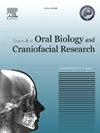Effective treatment of oral microbial infections and biofilm using flavonoid rutin - An in vitro study
Q1 Medicine
Journal of oral biology and craniofacial research
Pub Date : 2025-03-23
DOI:10.1016/j.jobcr.2025.03.007
引用次数: 0
Abstract
Background
Oral microbial infections and biofilm-associated conditions, such as dental caries, gingivitis, and periodontitis, remain major challenges in oral healthcare. Biofilms provide resistance to conventional antimicrobial treatments, necessitating innovative solutions. This study investigates rutin, a flavonoid glycoside, for its antimicrobial and antibiofilm properties against key oral pathogens.
Aim
To evaluate the antibacterial and antibiofilm efficacy of rutin against oral pathogens, including Streptococcus mutans, Pseudomonas aeruginosa, and Candida albicans, and assess its hemocompatibility as a safe therapeutic agent.
Methodology
Oral pathogens were isolated from clinical samples and identified using the VITEK®2 Compact System. Antimicrobial activity of five flavonoids was screened using the well diffusion method, with rutin demonstrating the highest efficacy. Minimum inhibitory concentration (MIC) and antibiofilm activity were assessed using broth microdilution and crystal violet staining, respectively. Confocal Laser Scanning Microscopy analyzed live/dead cells in treated biofilms. Hemocompatibility was evaluated via a hemolysis assay.
Results
Rutin exhibited significant antimicrobial activity with zone of inhibition as 19 mm (C. albicans), 17 mm (P. aeruginosa), and 17 mm (S. mutans). MIC against mixed biofilms was 10 mM, while treatment at 2 × MIC reduced biofilm biomass by 92 %. Live/dead analysis confirmed extensive microbial cell death in biofilms. Hemolysis rates below 5 % established rutin's biocompatibility.
Conclusion
Rutin demonstrates potent antimicrobial and antibiofilm efficacy with excellent safety, suggesting its potential as an alternative therapy for biofilm-associated oral infections. Further in vivo studies are warranted to validate these findings.

黄酮类芦丁有效治疗口腔微生物感染及生物膜的体外研究
口腔微生物感染和生物膜相关疾病,如龋齿、牙龈炎和牙周炎,仍然是口腔保健的主要挑战。生物膜对传统的抗菌素治疗具有耐药性,因此需要创新的解决方案。本研究研究了芦丁(一种黄酮类苷)对主要口腔病原体的抗菌和抗生物膜特性。目的评价芦丁对变形链球菌、铜绿假单胞菌、白色念珠菌等口腔病原菌的抗菌和抗生物膜作用,并评价其作为一种安全的治疗药物的血液相容性。方法从临床样品中分离病原菌,使用VITEK®2 Compact System进行鉴定。采用孔扩散法对5种黄酮类化合物进行抑菌活性筛选,以芦丁的抑菌活性最高。最低抑菌浓度(MIC)和抗菌膜活性分别用微肉汤稀释法和结晶紫染色法测定。共聚焦激光扫描显微镜分析处理过的生物膜中的活细胞和死细胞。通过溶血试验评估血液相容性。结果芦丁对白色念珠菌的抑制区为19 mm,对铜绿假单胞菌的抑制区为17 mm,对变形链球菌的抑制区为17 mm。混合生物膜的MIC为10 mM,而2倍MIC处理使生物膜生物量减少92%。活/死分析证实生物膜中大量微生物细胞死亡。溶血率低于5%确立了芦丁的生物相容性。结论芦丁具有较强的抗菌和抗生物膜作用,安全性好,有望成为生物膜相关性口腔感染的替代治疗药物。需要进一步的体内研究来验证这些发现。
本文章由计算机程序翻译,如有差异,请以英文原文为准。
求助全文
约1分钟内获得全文
求助全文
来源期刊

Journal of oral biology and craniofacial research
Medicine-Otorhinolaryngology
CiteScore
4.90
自引率
0.00%
发文量
133
审稿时长
167 days
期刊介绍:
Journal of Oral Biology and Craniofacial Research (JOBCR)is the official journal of the Craniofacial Research Foundation (CRF). The journal aims to provide a common platform for both clinical and translational research and to promote interdisciplinary sciences in craniofacial region. JOBCR publishes content that includes diseases, injuries and defects in the head, neck, face, jaws and the hard and soft tissues of the mouth and jaws and face region; diagnosis and medical management of diseases specific to the orofacial tissues and of oral manifestations of systemic diseases; studies on identifying populations at risk of oral disease or in need of specific care, and comparing regional, environmental, social, and access similarities and differences in dental care between populations; diseases of the mouth and related structures like salivary glands, temporomandibular joints, facial muscles and perioral skin; biomedical engineering, tissue engineering and stem cells. The journal publishes reviews, commentaries, peer-reviewed original research articles, short communication, and case reports.
 求助内容:
求助内容: 应助结果提醒方式:
应助结果提醒方式:


